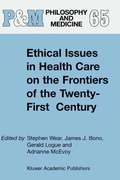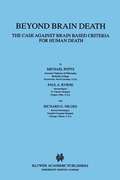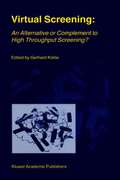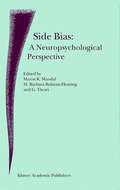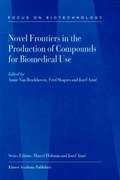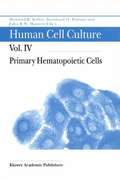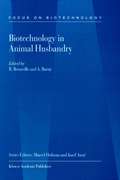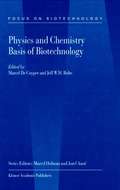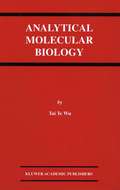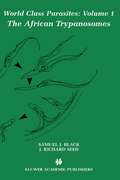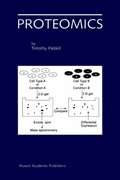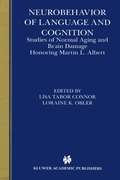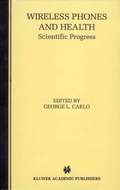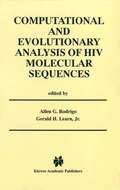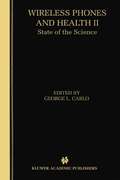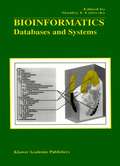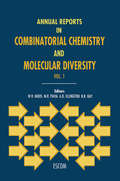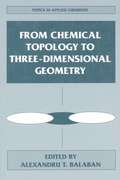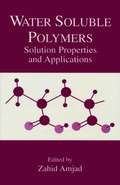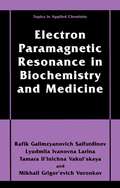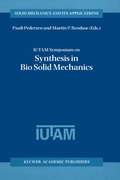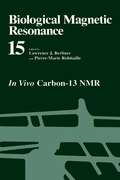- Table View
- List View
Cancer Cell Lines: Part 3: Leukemias and Lymphomas (Human Cell Culture #3)
by John Masters Bernhard Ø. PalssonThis book describes all human leukemia-lymphoma cell lines that have been established and that grow continuously under standardised in vitro conditions. These lines are derived from cells belonging to all the major hematopoietic cell lineages, i.e. B- and T-lymphocytes, natural killer cells, granulocytic cells and megakaryocytic cells. The clinical data, the culture conditions and the major phenotypic features of the cell lines are described with citations. This book is the first book describing human leukemia-lymphoma cell lines and will be of interest to scientists involved in the areas of hematology, oncology, immunology, molecular biology and cytogenetics. Cancer Cell Lines, Volumes 1-3: These 3 volumes provide a comprehensive text on the culture of established cell lines from every type of human cancer. The volumes provide a basic manual and reference resource for every cancer research scientist using human cancer cells.
Ethical Issues in Health Care on the Frontiers of the Twenty-First Century (Philosophy and Medicine #65)
by Stephen Wearof UB’s medical school, that UB developed its School of Arts and Sciences, and thus, assumed its place among the other institutions of higher education. Had Fillmore lived throughout UB’s first seventy years, he would probably have been elated by the success of his university, and he should have been satisfied and pleased that UB remained intrinsically bonded to its community while at the same time engrafting the values and standards important to higher education’s mission in the region. UB and its medical school have undergone many challenging transitions since 1846. Included among them were: (1) the completion of an academic campus in the far northeast comer of the City of Buffalo while leaving its medical, dental and law schools firmly situated in the core of downtown Buffalo; (2) the eventual relocation, after the second world war, of the law school to the newer campus in Amherst, and the medical and dental school to the original academic campus: and (3) the merger with the State University of New York System in 1962. Despite these significant transitions, any one of which could have changed the intrinsic integrity of UB and disrupted the bonding between community and university, that did not happen. To this day, the ties between community and academe persist. Fillmore and White should celebrate their success and important contribution to Buffalo and Western New York.
Peptides: Biology and Chemistry (Chinese Peptide Symposia)
by James P. Tam Xiao-Yu Xiao-Yu Hu Rui Rui WangThe Fifth Chinese Peptide Symposium, hosted by Lanzhou University, was held at Lanzhou, China July 14-17, 1998, with 156 participants, including 30 scientists from abroad, representing nine countries. The four-day conference was both intense and spiritually rewarding. Our goal for CPS-98 was to provide a forum for the exchange of knowledge, cooperation and friendship between the international and Chinese scientific communities, and we believe this goal was met. The symposium consisted of 8 sessions with 42 oral and 90 poster presentations, including synthetic methods, molecular diversity and peptide libraries, structure and conformation of peptides and proteins, bioactive peptides, peptide immunology, De Novo design and synthesis of proteins and peptides, ligand-receptor interactions, the chemistry-biology-interface and challenging problems in peptides. The enthusiastic cooperation and excellent contributions were gratifying and the active response of the invited speakers contributed to the success of the symposium. The presentations were of excellent caliber and represented the most current and significant aspects of peptide science. Dr. Kit Lam of the University of Arizona and Dr. Yun-Hua Ye of Peking University were the recipients of “The Cathay Award” sponsored by the H. H. Liu Education Foundation, offered for their seminal contribution in peptide science and the Chinese Peptide Symposium. Four outstanding young scientists were selected by the organizing committee to receive awards sponsored by Haikou Nanhai Pharmaceutical Industry Co. Ltd. (Zhong He Group).
Beyond Brain Death: The Case Against Brain Based Criteria for Human Death (Philosophy and Medicine #66)
by P. A. Byrne R. G. Nilges M. PottsBeyond Brain Death offers a provocative challenge to one of the most widely accepted conclusions of contemporary bioethics: the position that brain death marks the death of the human person. Eleven chapters by physicians, philosophers, and theologians present the case against brain-based criteria for human death. Each author believes that this position calls into question the moral acceptability of the transplantation of unpaired vital organs from brain-dead patients who have continuing function of the circulatory system. One strength of the book is its international approach to the question: contributors are from the United States, the United Kingdom, Liechtenstein, and Japan. This book will appeal to a wide audience, including physicians and other health care professionals, philosophers, theologians, medical sociologists, and social workers.
Virtual Screening: Proceedings of the Workshop ‘New Approaches in Drug Design and Discovery’, special topic ‘Virtual Screening’, Schloß Rauischholzhausen, Germany, March 15–18, 1999
by Gerhard KlebeIn the next couple of years the human genome will be fully sequenced. This will provide us with the sequence and overall function of all human genes as well as the complete genome for many micro-organisms. Subsequently it is hoped, by means of powerful bioinformatic tools, to determine the gene variants that contribute to various multifactorial diseases and genes that exist in certain infectious agents but not humans. As a consequence, this will allow us to define the most appropriate levels for drug intervention. It can be expected that the number of potential drug targets will increase, possibly by a factor of 10 or more. Nevertheless, sequencing the human genome or, for that matter, the genome of other species will only be the starting point for the understanding of their biological function. Structural genomics is a likely follow-up, combined with new techniques to validate the therapeutic relevance of such newly discovered targets. Accordingly, it can be expected that in the near future we will witness a substantial increase in novel putative targets for drugs. To address these new targets effectively, we require new approaches and innovative tools. At present, two alternative, yet complementary, techniques are employed: experimental high-throughput screening (HTS) of large compound libraries, increasingly provided by combinatorial chemistry, and computational methods for virtual screening and de novo design. As kind of status report on the maturity of virtual screening as a technique in drug design, the first workshop on new approaches in drug design and discovery was held in March 1999, at Schloß Rauischholzhausen, near Marburg in Germany. More than 80 scientists gathered and discussed their experience with the different techniques. The speakers were invited to summarize their contributions together with their impressions on the present applicability of their approach. Several of the speakers followed this request which is summarized in this publication.
Side Bias: A Neuropsychological Perspective
by Manas K. Mandal`Rather than being an esoteric aspect of brain function, lateralization is a fundamental characteristic of the vertebrate brain essential to a broad range of neural and behavioral processes.' Professor Lesley J. Rogers, Chapter 1 of Side Bias: A Neuropsychological Perspective. This volume contains 14 chapters from a veritable `United Nations' of experts in the field of lateralization of function. They write comprehensive reviews, present data, and pose new questions concerning the evolutionary origins and development of side bias, methodological concerns with the way we measure handedness and footedness, and some more unusual aspects of human beings' lateralized behavior, such as asymmetrical cradling and pseudoneglect. The book will be essential reading for students of behavioral neuroscience and neuropsychology interested in lateralization of function as well as for established researchers in the field.
Novel Frontiers in the Production of Compounds for Biomedical Use (Focus on Biotechnology #1)
by Fred Shapiro Jozef Anné A. Van BroekhovenThe present book entitled “Novel Frontiers in the Production of Compounds for Biomedical Uses” can perhaps be placed in its best perspective by the Shakespearean character in The Tempest who exclaimed" What’s past is prologue”. Indeed, this compilation of some of the outstanding presentations in the field of biomedicine made at th the 9 European Congress on Biotechnology (Brussels, Belgium, July 11-15, 1999) not only reflects the achievements of the recent past, but provides a privileged glimpse of the biotechnology that is emerging in the first decade of the new Millennium. It is becoming increasingly apparent that biotechnology is offering biomedicine novel approaches and solutions to develop a sorely needed new generation of biopharmaceuticals. This is all the more necessary because in recent years, new diseases have emerged with extraordinary lethality in all corners of the globe, while age-related chronic illnesses have filled the gap wherever biomedicine has made successful inroads. The rise of antibiotic resistance also poses major threats to public health. Thus, as disease patterns evolve, the rational development of new drugs is becoming urgent, not only for the clinical outcome of patients, but also in optimising the allocation of scarce health care resources through the use of cost-effective productions methods. It is in response to all these challenges that biotechnology offers new strategies that go beyond the more traditional approaches. By the mid-1990’s, the number of recombinant products approved annually for therapeutic use reached double digits. With the advent of the genomics revolution.
Human Cell Culture: Primary Hematopoietic Cells (Human Cell Culture #4)
by Bernhard Ø. Palsson F. Koller John MastersThe daily production of hundreds of billions of blood cells through the process of hematopoiesis is a remarkable feat of human physiology. Transport of oxygen to tissues, blood clotting, antibody- and cellular-mediated immunity, bone remodeling, and a host of other functions in the body are dependent on a properly functioning hematopoietic system. As a consequence, many pathological conditions are attributable to blood cell abnormalities, and a fair number of these are now clinically treatable as a direct result of hematopoietic research. Proliferation of hematopoietic stem cells, and their differentiation into the many different lineages of functional mature cells, is highly regulated and responsive to many environmental and physiological challenges. Our relatively advanced understanding of this stem cell system provides potentially important insights into the regulation of development in other tissues, many of which are now being acknowledged as stem ce- based, perhaps even into adulthood. The recent public and scientific fanfare following announcement of human embryonic stem cell studies suggests that stem cell research will continue to be a relevant and exciting topic.
Biotechnology in Animal Husbandry (Focus on Biotechnology #5)
by R. Renaville A. BurnyAnimal biotechnology is a broad umbrella encompassing the polarities of fundamental and applied research including molecular modelling, molecular and quantitative genetics, gene manipulation, development of diagnostics and vaccines and manipulation of tissue or digestion metabolism by growth promoters. Although animal biotechnology in the broadest sense is not new, what is new is the level of complexity and precision involved in scientists' current ability to manipulate living organisms. This new book sets out to show that the important ideas in animal biotechnology are exciting and relevant to everyday experience. It represents an important update of the literature for research workers, lecturers, and advisers in animal science, but is also a core text for advanced undergraduate courses in animal science and biotechnology. It will be an essential acquisition for librarians in agriculture and veterinary science.
Physics and Chemistry Basis of Biotechnology (Focus on Biotechnology #7)
by Jeff W. M. Bulte M. De CuyperAt the end of the 20th century, a tremendous progress was made in biotechnology in its widest sense. This progress was largely possible as a result of joint efforts of top academic researchers in both pure fundamental sciences and applied research. The surplus value of such interdisciplinary approaches was clearly highlighted during the 9th European Congress on Biotechnology that was held in Brussels, Belgium (11-15 July, 1999). The present volume in the ‘Focus on Biotechnology’ series, entiteld ‘Physics and Chemistry Basis for Biotechnology’ contains selected presentations from this meeting, A collection of experts has made serious efforts to present some of the latest developments in various scientific fields and to unveil prospective evolutions on the threshold of the new millenium. In all contributions the emphasis is on emerging new areas of research in which physicochemical principles form the foundation. In reading the different chapters, it appears that more than ever significant advances in biotechnology very often depend on breakthroughs in the biotechnology itself (e.g.
Analytical Molecular Biology
by Tai Te WuAnalytical Molecular Biology illustrates the importance of simple analytical methods applied to some basic molecular biology problems, with an emphasis on the importance of biological problems, rather than the complexity of mathematics. First, the book examines crucial experimental data for a specific problem. Mathematical models will then be constructed with explicit inclusion of biological facts. From such models, predictions can be deduced and then suggest further experimental studies. A few important molecular biology problems will be discussed in the order of the complexity of the mathematical models. Based on such illustrations, the readers can then develop their own analytical methods to study their own problems. This book is for anyone who knows they need to learn how to apply mathematical models to biology, but doesn't necessarily want to, from practicing researchers looking to acquire more analytical tools to advanced students seeking a clear, explanatory text.
The African Trypanosomes (World Class Parasites #1)
by Samuel J. Black J. Richard SeedAfrican trypanosomes are tsetse-transmitted protozoa that inhabit the extracellular compartment of host blood. They cause fatal sleeping sickness in people, and Nagana, a wasting and generally fatal disease, in cattle. While trypanosomes are most common to Africa (about 30% of Africa's cattle graze on the fringe of the tsetse habitat), some species have spread beyond its boarders to Asia, the Middle East and South America. The African Trypanosomes, volume one of World Class Parasites, is written for researchers, students and scholars who enjoy reading research that has a major impact on human health, or agricultural productivity, and against which we have no satisfactory defense. It is intended to supplement more formal texts that cover taxonomy, life cycles, morphology, vector distribution, symptoms and treatment. It integrates vector, pathogen and host biology and celebrates the diversity of approach that comprises modern parasitological research.
Proteomics
by Timothy PalzkillProteomics is an introduction to the exciting new field of proteomics, an interdisciplinary science that includes biology, bioinformatics, and protein chemistry. The purpose of this book is to provide the active researcher with an overview of the types of questions being addressed in proteomics studies and the technologies used to address those questions. Key subjects covered in this book include: an assessment of the limitations of this approach and outlines new developments in mass spectrometry that will advance future research high-throughput recombinant DNA cloning methods used to systematically clone all of the open reading frames of an organism into plasmid vectors for large scale protein expression and functional studies such as protein-protein interactions with the two-hybrid system protein structure an overview of large-scale experimental attempts to determine the three-dimensional structures of representative sets of proteins computational approaches to determining the three-dimensional structure of proteins. Proteomics provides a starting point for researchers who would like a theoretical understanding of the new technologies in the field, and obtain a solid grasp of the fundamentals before integrating new tools into their experiments. Written with attention to detail, but without being overwhelmingly technical, Proteomics is a user-friendly guide needed by most biologists today.
Neurobehavior of Language and Cognition: Studies of Normal Aging and Brain Damage
by Loraine K. Obler Lisa TaborConnorThis volume has been composed as an appreciation of Martin L. Albert in the year of his 60th birthday. At least one contributor to each paper in this volume has been touched by Marty in some way; lie has mentored some, been a fellow student with some, and been a colleague to most. These contributors, as well as many others, view Marty as a gifted scientist and a wonderful human being. The breadth of his interests and intellectual pursuits is truly impressive; this breadth is reflected, only in part. by the diversity of the papers in this volume. His interests have ranged from psychopharmacology to cross-cultural understanding of dementia, through the aphasias, to the history of the fields that touch on behavioral neurology, especially neurology per se, cognitive psychology, speech-language pathology, and linguistics. Throughout his scholarly work, Martha Taylor Sarno notes, Marty never loses the human perspective, e. g. , the “powerfully disabling effect on the individual person” with aphasia or other neurological disorder. For those readers who only how a portion of his work, we thought that we should describe him here. Many of the people whom Marty has influenced have been able to contribute to this volume. We have invited some others who were unable to contribute to express their appreciation for him, as well.
Wireless Phones and Health: Scientific Progress (Wireless Phones And Health Ser.)
by George L. CarloComputational and Evolutionary Analysis of HIV Molecular Sequences
by Allen G. Rodrigo Gerald H. LearnComputational and Evolutionary Analysis of HIV Molecular Sequences is for all researchers interested in HIV research, even those who only have a nodding acquaintance with computational biology (or those who are familiar with some, but not all, aspects of the field). HIV research is unusual in that it brings together scientists from a wide range of disciplines: clinicians, pathologists, immunologists, epidemiologists, virologists, computational biologists, structural biologists, evolutionary biologists, statisticians and mathematicians. This book seeks to bridge the gap between these groups, in both subject matter and terminology. Focused largely on HIV genetic variation, Computational and Evolutionary Analysis of HIV Molecular Sequences covers such issues as sampling and processing sequences, population genetics, phylogenetics and drug targets.
Wireless Phones and Health II: State of the Science (Wireless Phones And Health Ser.)
by George L. Carlo Polly M. ThibodeauFrom the time questions about the impact of wireless technology on public health were first raised in 1993 through the present, Wireless Technology Research, LLC (WTR) has been the largest independent surveillance and research program trying to identify and solve human health problems associated with wireless phones. In 1995 at the University “La Sapienza” of Rome, WTR sponsored the first comprehensive forum for the discussion of these issues. Papers from the 1995 State of the Science Colloquium were collected andpublished in Volume I ofthis series, Wireless Phones andHealth: Scientific Progress. This second volume assembles papers presented at WTR’s Second State of the Science Colloquium in Long Beach, CA, in June 1999; it contains the most comprehensive research on the public health impact of wireless phones to date. The operating words for the proper understanding of these data are science and public health. Science is a tool for making public health decisions, but the framework in which we are operating is truly that of public health. We are looking for problems that have to do with wireless technology. We are trying to decide how this technology impacts on the public for one purpose and one purpose alone, and that purpose is to solve problems that are identified. I would like to challenge you, the reader, to suspend your parochial orientation as you consider these latest findings.
Constraints on Language: Aging, Grammar, And Memory
by Susan KemperSusan Kemper A debate about the role of working memory in language processing has become center-most in psycholinguistics (Caplan & Waters, in press; Just & Carpenter, 1992; Just, Carpenter, & Keller, 1996; Waters & Caplan, 1996). This debate concerns which aspects of language processing are vulnerable to working memory limitations, how working memory is best measured, and whether compensatory processes can offset working memory limitations. Age-comparative studies are particularly relevant to this debate for several reasons: difficulties with language and communication are frequently mentioned by older adults and signal the onset of Alzheimer's dementia and other pathologies associated with age; older adults commonly experience working memory limitations that affect their ability to perform everyday activities; the rapid aging of the United States population has forced psychologists and gerontologists to examine the effects of aging on cognition, drawing many investigators to the study of cognitive aging. Older adults constitute ideal population for studying how working memory limitations affect cognitive performance, particularly language and communication. Age-comparative studies of cognitive processes have advanced our understanding of the temporal dynamics of cognition as well as the working memory demands of many types of tasks (Kliegl, Mayr, & Krampe, 1994; Mayr & Kliegl, 1993). The research findings reviewed in this volume have clear implications - for addressing the practical problems of older adults as consumers of leisure ti- reading, radio and television broadcasts, as targets of medical, legal, and financial documents, and as participants in a web of service agencies and volunteer activities.
Bioinformatics: Databases and Systems
by Stanley LetovskyBioinformatics brings computational methods to the analysis and processing of genomic data. Bioinformatics: Databases and Systems focuses on the issues of system building and data curation that dominate the day-to-day concerns of bioinformatics practitioners. Included are chapters by many of today's leading bioinformatics practitioners, describing most of the current paradigms of system building and curation, including both their strengths and weaknesses. Biological topics covered include sequence databases, metabolic pathways, phenotypes, variety collections, gene expression atlases and neuroinformatics. Species range from bacteria to mammals to plants. Software systems and technologies covered include OPM, CORBA, SRS, KLEISLI, ACEDB, Web-based integration and laboratory workflow. Bioinformatics: Databases and Systems provides a valuable introduction for newcomers to the field, and a useful reference for veterans.
Annual Reports in Combinatorial Chemistry and Molecular Diversity (Annual Reports in Combinatorial Chemistry & Molecular Diversity #1)
by W.H. Moos, M.R. Pavia, B.K. Kay and A.D. EllingtonCombinatorial chemistry and molecular diversity approaches to scientific inquiry and novel product R&D have exploded in the 1990s! For example, in the preparation of drug candidates, the automated, permutational, and combinatorial use of chemical building blocks now allows the generation and screening of unprecedented numbers of compounds. Drug discovery - better, faster, cheaper? Indeed, more compounds have been made and screened in the 1990s than in the last hundred years of pharmaceutical research. This first volume covers: (i) combinatorial chemistry, (ii) combinatorial biology and evolution, and (iii) informatics and related topics. Within each section chapters are prepared by experts in the field, including, for example, in Section I: Coverage of mixture pools vs. parallel individual compound synthesis, solution vs. solid-phase synthesis, analytical tools, and automation. Section II highlights selection strategies and library-based evolution, phage display, peptide and nucleic acid libraries. Section III covers databases and library design, high through-put screening, coding strategies vs. deconvolutions, intellectual property issues, deals and collaborations, and successes to date.
From Chemical Topology to Three-Dimensional Geometry (Topics in Applied Chemistry)
by Alexandru T. BalabanEven high-speed supercomputers cannot easily convert traditional two-dimensional databases from chemical topology into the three-dimensional ones demanded by today's chemists, particularly those working in drug design. This fascinating volume resolves this problem by positing mathematical and topological models which greatly expand the capabilities of chemical graph theory. The authors examine QSAR and molecular similarity studies, the relationship between the sequence of amino acids and the less familiar secondary and tertiary protein structures, and new topological methods.
Water Soluble Polymers: Solution Properties and Applications
by Zahid AmjadThis volume contains a series of papers originally presented at the symposium on Water Soluble Polymers: Solution Properties and Applications, sponsored by the Division of Colloids and Surface Chemistry of the American Chemical Society. The symposium took place in Las Vegas City, Nevada on 9 to 11th September, 1997 at the 214th American Chemical Society National Meeting. Recognized experts in their - spective fields were invited to speak. There was a strong attendance from academia, g- ernment, and industrial research centers. The purpose of the symposium was to present and discuss recent developments in the solution properties of water soluble polymers and their applications in aqueous systems. Water soluble polymers find applications in a number of fields of which the following may be worth mentioning: cosmetics, detergent, oral care, industrial water treatment, g- thermal, wastewater treatment, water purification and reuse, pulp and paper production, sugar refining, and many more. Moreover, water soluble polymers play vital role in the oil industry, especially in enhanced oil recovery. Water soluble polymers are also used in ag- culture and controlled release pharmaceutical applications. Therefore, a fundamental kno- edge of solution properties of these polymers is essential for most industrial scientists. An understanding of the basic phenomena involved in the application of these polymers, such as adsorption and interaction with different substrates (i. e. , tooth enamel, hair, reverse - mosis membrane, heat exchanger surfaces, etc. ) is of vital importance in developing high performance formulations for achieving optimum efficiency of the system.
Electron Paramagnetic Resonance in Biochemistry and Medicine (Topics in Applied Chemistry)
by Rafik Galimzyanovich Sajfutdinov Lyudmila Ivanovna Larina Tamara Il'inichna Vakul'skaya Mikhail Grigor'evich VoronkovElectron Paramagnetic Resonance (EPR) spectroscopy - also sometimes termed Electron Spin Resonance spectroscopy - has manifold potential uses in biochemistry and medicine. The paramount importance of EPR spectroscopy applied to biological tissues and fluids is that it identifies the changes in redox processes that contribute to disease. EPR spectroscopy has come a long way from its original use to detect malignant tumors. For example, the development and later refinement of methods of low-temperature registration of biological tissues widened the scope of EPR spectroscopy. Innovations made possible by the introduction of spin labels, probes, and traps made EPR spectroscopy ever more applicable to biochemistry and medicine, to the point where in vivo studies are being carefully considered. This comprehensive book discusses spectra of many tissues and bodily fluids, and the quantitative nature of paramagnetic centers in both normal individuals and patients suffering from a variety of diseases. Special attention is given to the EPR examination of bio-molecules, such as enzymes, polypeptides, vitamins, lipids, hydrocarbons, etc., which play an essential role in human activity. This book will be of great interest to physicians specializing in many different areas. Similarly, biologists, biochemists, biophysicists, and chemists will find this book very useful. It has also been written so that it may be used as a textbook at graduate level.
IUTAM Symposium on Synthesis in Bio Solid Mechanics: Proceedings of the IUTAM Symposium held in Copenhagen, Denmark, 24–27 May 1998 (Solid Mechanics and Its Applications #69)
by Pauli Pedersen Martin P. BendsøeThis book contains the edited version of invited lectures presented at the IUTAM-Sym- sium Synthesis in Bio Solid Mechanics, held at Hotel Frederiksdal, Virum (Copenhagen), Denmark, May 24 to May 27, 1998. The symposium was attended by 48 scientist from 14 countries. Biomechanics has been a very active research area in the last 25 years and covers a very broad class of problems. The present symposium concentrated on the solid mechanics - main of biomechanics, where important problems of synthesis presently are an active and challenging part. Characteristics of biomechanical materials are not only the inhomogeneity and anisotropy, but also the capability to change in relation to actual use. These living materials call for new methods of analysis and also new methods for synthesis. By the synthesis in this context is meant design of implants or artificial control of material growth. Bone mechanics is closely related to recent work on analysis and design of microstructural anisotropic materials. Also, recent work in shape design can to some extent be useful in the more complicated problems of biomechanics. Here interface problems play an essential role. The symposium brought together scientists from mechanics, mathematics and medicine.
Biological Magnetic Resonance: In Vivo Carbon-13 NMR (Biological Magnetic Resonance #15)
by Lawrence J. Berliner Pierre-Marie RobitailleThis volume constitutes a compilation of the latest experiments and theories on a rapidly evolving and maturing field in MRI/MRS, which is the use of the stable isotope 13-C. The 13-C is used to probe the chemistry, mechanism, and function in living systems. All the chapters are written by experts in the field who discuss topics such as `Tracer Theory and the Suitability of 13-C NMR', `Applications of 13-C to Studies of Human Brain Metabolism', etc.

